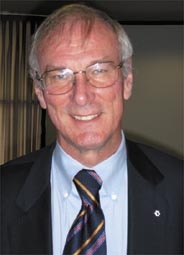Nicotine addiction
by Ian Mason PhD
Like obesity it is harder to treat than high BP or cholesterol. Now Spanish cardiologists are urging a new approach to patients who smoke.

We are facing a Tsunami of preventable disease in years to come
Over 50% of physicians do not have time to help smokers quit and 38% feel inappropriately trained, according to results from one of the largest international surveys of physicians’ attitudes to smoking cessation, presented during September’s European Society of Cardiology meeting in Barcelona. Smoking is currently the world’s leading preventable cause of premature death. In the EU, one hospitality industry employee dies each day due to exposure to tobacco smoke, but this is just the tip of the iceberg, said Professor Bryan Williams, University of Leicester, UK: ‘Each year smoking kills 1.2 million people in Europe, including 450,000 from cardiovascular disease. Passive smoking is also associated with significant morbidity and mortality, including 7,000 deaths due to passive smoking at work and 72,000 deaths due to passive smoking at home.’
In the face of this alarming toll, an overwhelming majority of physicians surveyed said that smoking is difficult to treat – more difficult than high blood pressure or high cholesterol and on a par with obesity.
In the survey, some 2,836 physicians from 16 countries including France, Germany, Greece, Italy, Netherlands, Poland, Spain, Sweden, Switzerland, Turkey, UK were interviewed.
‘The results highlight the practical difficulties doctors face in helping their patients quit smoking,’ said Professor Robert West, Cancer Research UK. ‘Whilst the considerable health risks associated with smoking are now relatively well known, the realities of enabling people to stop are proving more challenging. It is vital that smokers receive practical support and advice for quitting smoking from their doctors.’
Interestingly, the survey found a difference of opinion between physicians who smoke and those who do not. Only 57% of physicians who smoke stated ‘smoking’ as the most harmful activity for their patients, compared with 73% of non-smoking physicians, suggesting that some physicians who smoke may be underestimating the harmful effects of smoking.
Though a significant percentage of physicians say they discuss smoking with their smoking patients on every visit, or occasionally, their discussions generally focus either on repeating widely available public health messages or information gathering rather than actually facilitating quitting. Only 47% help the smoker develop a plan to quit, 39% recommend an over-the-counter (OTC) medication and 29% prescribe a prescription medication. North American doctors are more proactive with 76% helping the smoker to develop a plan to quit and 57% prescribing a medication, compared with 43% and 21% respectively in Europe.
The vast majority of doctors understand why quitting smoking is so difficult. Nearly all agree that smoking is an addictive behaviour and 81% consider it a chronic, relapsing medical condition. Indeed, 71% agree that smoking should be classified as a medical condition and 64% believe that if this were to happen, it would encourage more smokers to quit.
‘To successfully combat deaths caused by smoking, everybody, both physicians and non-physicians, needs to reframe how we talk and think about smoking,’ said Professor
Serena Tonstad, Department of Preventive Cardiology, Ulleval University Hospital, Norway. ‘Smoking is not a manifestation of a weak will or character, but a chronic relapsing medical condition caused by tobacco dependence. Many smokers may require medical treatment for this condition, because most smokers are addicted to inhaled nicotine. This addiction ultimately takes the life of one out of two smokers prematurely.’
When asked what would make it easier for them to help smokers to quit doctors were very clear.They agreed that they want more effective medication (81%), additional coaching on how to communicate and motivate smokers to quit (78%), and more widely pub-licised smoking cessation success rates (77%).
Professor Williams said that by 2010, the WHO estimates that the annual global cost of tobacco-related illness will be ¤407 billion. ‘The number of Europeans dying from CVD due to smoking rose by 13% from 1990–2000. Although smoking has declined in many European countries, the rate of decline is now slowing. It is quite clear that in certain regions of Europe, particularly Eastern Europe, smoking rates are continuing to rise so I do not expect that the numbers dying from cardiovascular disease attributable to smoking will fall until new strategies begin to bite.’
The WHO estimates that under 5% of smokers who try to quit unaided manage to remain abstinent at one year. The physician has an important role to play as a ‘partner’ in helping patients quit, as well as providing professional advice and treatments to overcome tobacco dependence.
Professor Andrew Pipe, University of Ottawa Heart Institute, Canada, said that 86% of people in the EU are in favour of smoking bans in offices and other indoor workplaces, with 61% in favour of smoking bans in bars or pubs. Support is highest in countries where a ban has been implemented for more than one year, such as Italy, Sweden and Ireland.
‘We are facing a Tsunami of preventable disease in years to come. It is so huge as to be almost incomprehensible,’ said Professor Pipe. ‘The evidence is quite clear, in Europe as elsewhere, that there is a huge burden of unnecessary morbidity and mortality which is produced by addiction to nicotine.’
14.11.2006









